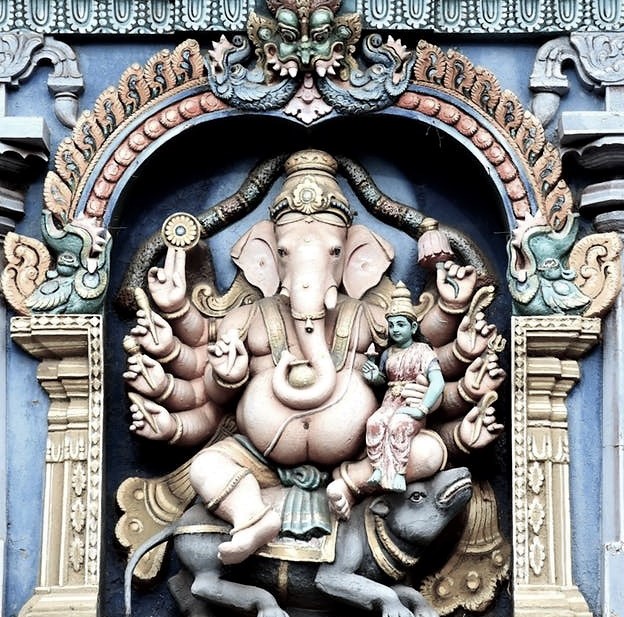- Special FeaturesFoundation Year400-425 CESthala TreeTheerthamRathamArchitectureOther SpecialityThere is one special thing about the statue of Maa Kali, during Navratri the neck of Maa Kali’s statue is slightly tilted from its original position.
- Sthala Puran
Tigawa is a village in Indian state of Madhya Pradesh and an archaeological site with a complex of about 36 Hindu temple ruins. Of these, the small but important and ancient Kankali Devi Temple is in good condition, and is usually dated to about 400-425 CE.
Kankali Devi Temple is most notable and is a Gupta period temple. It is one of the oldest surviving Hindu temples, illustrating the formative stages of Hindu temple architecture and the essential elements found in the north Indian style through the modern era. It has a sanctum and an open portico supported on four pillars. The sides of the portico were filled in with walls containing panels at a later period. The sanctuary is, and always was, covered with a flat roof, and is generally very similar to the Gupta period Temple 17 at Sanchi.
Despite its name, the temple was also dedicated to Vishnu, with other elements added later. An image of him as Narasimha is placed inside the sanctum. The portico has an image of the Sheshashai Vishnu (Narayana) and another one of Chamunda (Kankali Devi). Projecting from the front of the portico is a later relief of a seated Vishnu in the yoga asana position with a serpent hood above the head.
- Architecture
The Kankali Devi temple has a square sanctum with a 12.5 feet (3.8 m) side outside and 8 feet (2.4 m) side inside. The sanctum does not open exactly to the east, but deviates by about 13 degrees, which Cunningham speculated may be intentional and related to "one nakshatra" (lunar house, Hindu calendar).
The temple has an open portico supported on four pillars that projects 7 feet (2.1 m) in front of the sanctum. Both the pillared porch and the sanctum are on a raised plinth, its roof made from horizontal slabs of stone.The pillars of the mandapa are massive, shaped into three symmetric cross sections: a long square sectioned part close to the ground, above it an octagonal and sixteen-edged. Above these is a circular part capped with pot and foliage capitals. On top of the pillars are sculptures of two crouching lions with a tree separating them. The pillars are identical in all respects except the tree: one pillar has a mango tree, another a palm, while the other two trees unclear.The portico was partially walled later, according to Percy Brown.
The temple door jambs are intricately carved, in vertical bands that are concentric around the entrance. On top left of the entrance wall is river goddess Ganga holding a water vessel and riding her crocodile vahana, while the top right has river goddess Yamuna also holding a water vessel while riding her tortoise vahana.Goddess Ganga is plucking a fruit from custard-apple tree, while Yamuna is plucking one from a mango tree.
The Kankali Devi Temple has reliefs showing Vishnu and generally considered to have been dedicated to Vishnu of Vaishnavism. An image of Narasimha, the man-lion avatar of Vishnu, is placed inside the sanctum. The portico has an image of the Sheshashai Vishnu (Narayana). Another shows Varaha, the man-boar avatar of Vishnu.
In front of the temple is a seated Vishnu image in yoga asana position with serpent hood above the head, similar to seated Tirthankaras and the Buddha. The temple also reverentially displays Shaktism and Shaivism themes, including a Chamunda (Kankali Devi) panel which gives the temple its name. On the wall opposite to Kankali Devi is Kali Devi (fierce form of Durga). Cunningham proposed that these Shaiva and Vaishnava reliefs were probably added around the 8th-century.
The Kankali Devi temple is similar to the Gupta period Temple #17 at Sanchi, with both illustrating the basic elements of Hindu sacred architecture. The temple style is also similar to the Hindu cave temples of Udayagiri and the Eran temple, both of which can be dated to be from the Gupta era because of the inscriptions found there.
A 7th or 8th-century CE Sanskrit inscription mentions the visit of a Umadeva of Kanyakubja, son of Samanya Bhatta, who had come to worship at the temple of Sitabhadra. There are also two inscriptions in Sankha Lipi.
- Alankar of Deity
- Prayers and BenefitsSpecial Vratas and PrayersOfferings to DeityStotras and Mantras
- FestivalsNavratre
- Sodasha Upcharas
- Prasadhas
- Social ActivitiesAnnadhanMarriageEar BoringHead ShaveDanaasEducation FacilitiesSocial DrivesOther Activities
- Arjita Seva
- Tags

